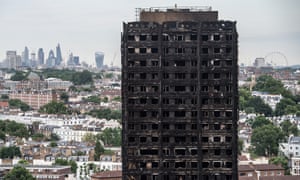
The Royal Borough of Kensington and Chelsea (RBKC) last year raised more money from the sale of two council houses in the rich south of the borough than it spent on the devastated Grenfell Tower’s new cladding, financial records obtained by the Guardian have revealed.
The contrast between the council’s wealth and its drive to cut costs on the tower refurbishment has been laid bare in council documents that reveal the Conservative-controlled council raised £4.5m from the sale of two three-bedroom houses in affluent Chelsea. It spent just £3.5m on the whole of the cut-price cladding system for 120 homes, which burned with such ferocity last month in a blaze that claimed at least 80 lives.
The two council houses on St Luke’s Street were close to the luxury shops of King’s Road in Chelsea and were originally priced at a combined £3.25m, but sold for £1.25m above that. One was bought by a multimillionaire property investor who has been granted permission to dig out a basement extension.
They were among a dozen council houses sold off by the borough in the year to April, raising £8m, according to figures released. The council has “usable reserves” of £274m and in 2014, when costs were being cut on Grenfell, its finances were so buoyant it awarded a £100 council tax rebate to residents paying the top rate.
The financial documents obtained by the Guardian reveal that the council earns £11m a year from leasing its large property portfolio to tenants including the fashion designer Stella McCartney and the elite Notting Hill preparatory school.
They confirm that almost £300,000 was cut from the cost of the cladding system used on Grenfell Tower by changing from zinc to aluminium as part of what was described internally as a “value engineering process”. Zinc panels with a fire retardant core were replaced by cheaper aluminium panels with a core that has since proved combustible in government tests.
Cuts were made to the way the gas risers fitted inside Grenfell’s internal corridors were treated, the documents reveal. About £60,000 worth of intended works to duct panels and ventilation grills for the risers were omitted, according to the documents.

RBKC has declined to answer detailed questions about the refurbishment, stating that it does not think it is right to disclose documents or make comments that might prejudice the forthcoming public inquiry. But the Guardian obtained the documents using a little-used open government provision that allows inspection of councils’ financial records for a limited period each year.
The new evidence of the disparity between the council’s cost-cutting on Grenfell Tower in the poor north of the borough and its valuable assets in the rich south is likely to increase pressure on the inquiry into the disaster to consider the impact of housing policies in the borough and the effect of gentrification.
It also comes as RBKC struggles to rehouse people who survived the fire in neighbouring blocks. The Grenfell response team said 169 offers had been made but only 35 had been accepted and only 10 households have so far been rehoused. The council this week acquired 31 more homes in the south of the borough, although families have said they want to remain in the north.

The retired judge chairing the inquiry, Sir Martin Moore-Bick, said this week he understood why victims and campaigners wanted him to examine how the social, political and cultural approach to housing contributed to the disaster. But he said that was something “some other sort of group with a different background, different skills, different training and expertise should be better placed [to do]”.
Cost-cutting has emerged as key theme in the Grenfell refurbishment. An email emerged last month that showed how a £293,368 cut was made to the cladding budget after the Kensington and Chelsea Tenant Management Organisation project manager told cost consultants: “I have been reminded that we need good costs for Cllr Feilding-Mellen [then deputy leader of RBKC] and the planner.” The panels eventually used on Grenfell Tower have now been withdrawn from sale and detectives from Scotland Yard are investigating the role of the cladding in an inquiry that senior officers have said could lead to manslaughter charges.
Among the documents obtained by the Guardian was an analysis of the contract sum for the Grenfell Tower refurbishment produced on behalf of the council’s tenant management organisation, which states the cost of “external facade (new wall, cassette fix aluminium cladding, windows without louvre panel over tile and turn windows, curtain walling)” was £3,476,855.
Some fire safety experts believe if more expensive non-combustible materials had been used, the spread of the fire could have been limited.
The Guardian has previously revealed that non-combustible insulation, such as mineral fibre, would have cost up to 50% more than the synthetic material used and that non-combustible cement-based panels – which are often used on prestige projects in the private sector – would have cost around twice as much as the flammable polyethylene-filled panels.
The standard of workmanship and the impact of internal fire safety strategies are also lines of inquiry.
In 2012 the original contractor, Leadbitter, said the project would cost £11.3mand planning drawings at this stage show the architects and engineers had proposed cladding with a fire-retardant core. The overall cost of the project was rejected as too expensive by RBKC and it appointed Rydon instead on a tighter budget of £8.7m. That followed a “value engineering process”, according to a report by Kensington and Chelsea’s housing and property scrutiny committee.
Laura Johnson, RBKC’s director of housing, told the council’s scrutiny committee in 2014 that Rydon “submitted the most economically advantageous tender, scoring highest on both price and quality”.
RBKC declined to comment on the sell-off of the multimillion-pound council homes as the cut-price works on Grenfell Tower were completed.
A spokesman said: “We know there are many questions relating to Grenfell Tower and fire safety standards and we are committed to cooperating fully with both the public inquiry and the criminal investigation. We do not think it is right to make comments relevant to the inquiry or subject to the investigation until this issue has been discussed with the police and the solicitors to the public inquiry once they have been appointed.”




